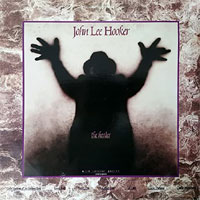John Lee Hooker • The Healer Chameleon Records/Craft Recordings CR00467
The latest testament to Hooker’s enduring legacy is Craft Recordings' decision to reissue his award-winning album The Healer after nearly 34 years since its first release and the sale of more than a million copies worldwide. One of the secrets to Hooker’s commercial stamina was his willingness to mingle with artists of any generation and background while still keeping his roots firmly planted in the Delta. Here he collaborates with an array of musicians, ranging from Carlos Santana and Bonnie Raitt to Los Lobos and George Thorogood. While there are a number of standout tracks on the album, particularly “That’s Alright” and “My Dream,” it’s Hooker’s voice that steals the show. Unlike with many septuagenarian singers, the instrument he was born with got better with every decade. His once-reedy notes gradually mellowed into rich, oaken tones that would resonate like the body of a hundred-year-old Martin guitar. Hooker’s phrasing here is also marked by nuances only a master craftsman can produce. On the Grammy-winning duet “I’m in the Mood,” his singing partner, Bonnie Raitt (who’s also in top form), has to work hard to match Hooker’s ability to bend notes with his voice in the same artful way he would stretch a slinky electric-guitar string with his fingers. If there’s a quibble here it would be with the clean shimmer of Roy Rogers’ 1980s-era production. In his defense, this leaner sound was standard operating procedure for producers of the time, and The Healer is by no means the worst example. The album's slight lack of warmth is only apparent when one compares it to Hooker’s later releases, which were made as the industry began returning to a more lush sound. So, is this Craft Recordings reissue worth the coin? Without a doubt. While I don’t have an original Chameleon pressing for comparison, Craft’s ultra-flat 180-gram pressing done at QRP in Salina, Kansas, is relatively free of the pops and surface noise all too common on some new vinyl releases, and enables listeners to better appreciate the album’s high quality. Bernie Grundman’s superb lacquer cut captures the full measure of Sam Lehmer’s dynamic mix, and the result wields a prodigious punch on any vinyl rig capable of delivering it. While blues purists may find fault with some of the
collaborations on The Healer, they actually serve as a reminder that the key to
artistic longevity is a willingness to keep taking risks. With this album, Hooker threw
the dice down hard and the gamble paid off. |

 f anyone ever
carves out a Mount Rushmore of blues icons, John Lee Hooker’s face would surely be on
it. From “Boogie ‘Chillen’,” his first charting single in 1948, to his
last recording dates in 2001, Hooker embodied the brooding, spooky mood of the Mississippi
Delta in a way few others did. In contrast to Mississippi Fred McDowell’s and Son
House’s struggles to balance their deeply religious upbringings with the wild life of
the juke joints they played in, Hooker carved out an unapologetic bad-boy image that he
carefully curated for more than fifty years. His jet-black Ray-Bans and tilted fedora
coupled with a laconic vocal swagger and hypnotic North Mississippi hill-country guitar
groove endowed him with a mystical aura of cool that was often copied but never matched.
f anyone ever
carves out a Mount Rushmore of blues icons, John Lee Hooker’s face would surely be on
it. From “Boogie ‘Chillen’,” his first charting single in 1948, to his
last recording dates in 2001, Hooker embodied the brooding, spooky mood of the Mississippi
Delta in a way few others did. In contrast to Mississippi Fred McDowell’s and Son
House’s struggles to balance their deeply religious upbringings with the wild life of
the juke joints they played in, Hooker carved out an unapologetic bad-boy image that he
carefully curated for more than fifty years. His jet-black Ray-Bans and tilted fedora
coupled with a laconic vocal swagger and hypnotic North Mississippi hill-country guitar
groove endowed him with a mystical aura of cool that was often copied but never matched.